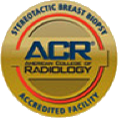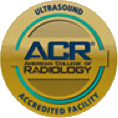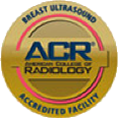
X-Ray Medical Group provides you with years of professional experience in ultrasound and a level of expertise unmatched in East San Diego County. Our ultrasound services cover a full range of conditions and is provided at a number of our convenient locations.
Ultrasound is a real-time imaging method, meaning the images are obtained continuously in a manner similar to a video camera. Real-time ultrasound can show the movement of internal tissues and organs, such as the flow of blood in arteries and veins, or the movement of a baby in a mother’s uterus. Ultrasound, otherwise known as ultrasonography or sonography, is a procedure in which sound waves are used to show structures in the human body. The sound waves reflect off of internal organs and other anatomic structures to create images, which a Radiologist can use to determine if the internal anatomy looks normal or abnormal. No ionizing radiation is used in an ultrasound procedure.
Hysterosonography is often used to investigate uterine abnormalities in women who experience infertility or multiple miscarriages. It is also a valuable technique in the evaluation of unexplained vaginal bleeding. Such conditions can result from uterine abnormalities such as congenital defects, masses, adhesions (or scarring), polyps, fibroids or atrophy. Hysterosonography is performed by inserting a small catheter into the uterus filling it with sterile saline. When the saline is inserted, it pushes the walls of the endometrium apart and allows a clear picture to be formed of its shape and size. If any part of the endometrial cavity appears irregular, it should be apparent to the Radiologist or sonographer.
Obstetric ultrasound refers to the specialized use of sound waves to visualize and thus determine the condition of a pregnant woman and her embryo or fetus. Obstetric ultrasound can determine and establish the following:
Ultrasound imaging is used extensively for evaluating the liver, kidneys, pancreas, gallbladder, spleen and blood vessels of the abdomen. Because it provides real-time images, it can also be used to:
Doppler ultrasound is a special type of ultrasound study that examines major blood vessels. These images can help the physician to see and evaluate:
In children, an abdominal ultrasound image is a useful way of examining internal organs including the appendix, liver, gallbladder, spleen, pancreas, intestines, kidneys and bladder. Ultrasound is particularly valuable for evaluating abdominal pain in young children.
Ultrasound imaging can:
Your child should be dressed in comfortable, loose-fitting clothing for an ultrasound exam. Other preparation depends on the type of examination. For some scans, your doctor may ask you to withhold food and drink for as many as 12 hours before your child's appointment. For others, you may be asked to have your child drink up to six glasses of water two hours prior to the exam and avoid urinating so that his or her bladder is full when the scan begins. Sedation is rarely needed for ultrasound examinations.
The primary use of ultrasound today is to help diagnose breast abnormalities detected by a physician during a physical exam and to characterize potential abnormalities seen on mammography.
Ultrasound imaging can help to determine if an abnormality is solid (which may be a non-cancerous lump of tissue or a cancerous tumor) or fluid-filled (such as a benign cyst). Ultrasound can also help show additional features of the abnormal area.
The most frequent reason for a carotid ultrasound exam is to detect narrowing, or stenosis, of the carotid artery, which substantially increases the risk of stroke. If your primary care physician detects high blood pressure or a carotid bruit (pronounced brU-E)—an abnormal sound in the neck that is heard with the stethoscope—carotid ultrasound may be needed. Other risk factors calling for ultrasound are advanced age, diabetes, elevated blood cholesterol, and a family history of stroke or heart disease.
If the exam shows narrowing of one or both carotid arteries, your physician may suggest medication, noninvasive angiography, or an operation to restore normal blood flow to the brain. In this way a stroke may be prevented.
A pelvic ultrasound usually focuses on the bladder and the prostate gland. Ultrasound images are captured in real-time, so they can show movement of internal tissues and organs, such as the flow of blood in arteries and veins.
For women, pelvic ultrasound is most often used to examine the uterus and ovaries and, during pregnancy, to monitor the health and development of the embryo or fetus.
A pelvic ultrasound exam can help identify stones, tumors and other disorders in the urinary bladder in men and women. Because ultrasound provides real-time images, it can also be used to guide procedures, like needle biopsies, in which a needle is used to sample cells from an abnormal area for laboratory testing. Doppler sonography is another method of ultrasound that can be used to evaluate blood flow in pelvic vessels.
You should wear comfortable, loose-fitting clothing for your ultrasound exam. For some scans you may be asked to drink up to six glasses of water two hours prior to your exam, so your bladder is full when the scanning begins. A full bladder helps with visualization of the uterus, ovaries and bladder wall.
Prostate ultrasound is used to detect possible disorders within a man's prostate gland. Ultrasound images can indicate when the prostate is enlarged or when there is an abnormal growth that might be cancer.
Ultrasound of the prostate may be warranted if a blood test result is elevated or if a nodule is felt by a physician during a routine physical exam or prostate cancer screening exam. An ultrasound exam can also indicate other types of prostate conditions, such as inflammation of the prostate, or it can be used to help diagnose the reasons for a man's infertility.
You should wear comfortable, loose-fitting clothing for your ultrasound exam. An enema is taken two to four hours before the ultrasound to clean out the bowel. Follow your doctor's instructions on bowel preparation. A full bladder helps with visualization of the prostate, so you may be asked to drink up to six glasses of water prior to your exam.
Ultrasound imaging of the scrotum is the primary imaging method used to evaluate disorders of the testicles and surrounding areas. It is used when a patient is experiencing pain or swelling in the scrotum, a mass has been felt by the patient or doctor, or there's been trauma to the scrotal area.
Scrotal ultrasound imaging can help determine the cause of testicular pain or swelling. Some of the problems ultrasound imaging can identify include: inflammation of the scrotum, an absent or undescended testicle, testicular torsion, abnormal blood vessels or a lump or tumor.
An ultrasound examination of the neck to help diagnosis a lump in the thyroid or a thyroid that is not functioning properly. The thyroid gland is located in front of the neck just below the Adam's apple and is shaped like a butterfly, with two lobes on either side of the neck connected by a narrow band of tissue.
Utrasound imaging of the body's veins and arteries can help our Radiologist see and evaluate blockages to blood flow, such as clots in veins and plaque in arteries.
Ultrasound of the vascular system also provides a fast, noninvasive means of identifying blockages of blood flow in the neck arteries to the brain that might produce a stroke or mini-stroke.
The most common reason for a venous ultrasound exam is to search for blood clots, especially in the veins of the leg.
Other reasons to do a venous ultrasound study:
When an ultrasound examination cannot characterize the nature of a breast abnormality; a physician may choose to perform an ultrasound-guided biopsy.
A breast biopsy involves removing some cells—either surgically or in a less invasive procedure involving a needle—from the suspicious area in the breast and examining them under a microscope to determine a diagnosis.
Ultrasound-guidance is used to assist physicians in obtaining tissue samples from the breast in three different biopsy procedures: a cyst aspiration, a fine needle aspiration (FNA) biopsy and a core needle (CN) biopsy.







